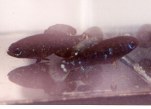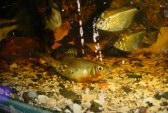 |
 |
 |
Suppliments
7-8-9
No,7

Name: - Ellassoma Evergladei.
Family: - Centrarchidae.
Origin: - North Carolina to Florida.
Size: - 3cms (u.s.a show size)
This little fish has a common name of the
“Florida Pigmy Sunfish”.
This is a quaint little fish which I first saw in a local breeders fish house.
After gentle persuasion? he gave me two pair to try and breed.
Around the same time I had arranged for a trip down south and I was very fortunate in my travels to pick up another four pairs and three spare males.
On return home I housed all the fish in an 18”x12”x10” tank. The base of the tank was covered in a thin layer of sand with a large clump of java moss added as a spawning medium.
The tank was filtered through a small bio foam sponge filter.
The pH was set between 6.5 - 7 and the temperature was kept cool at around 70f.
It is vital that when you are attempting to breed any fish, especially small fish, you must keep them in good condition.
To keep them in good breeding condition, the best feeding is Brine Shrimp and small live feeding, such as Daphnia and Micro Worm.
After a week I noticed that the females had laid eggs in the java moss, I had been told that they where good parents and so I took the advice I had been given and prayed.
Sure enough, the parents did not touch the eggs. After a day or so the eggs started to eye up and get bigger and after 3-4 days they started to hatch.
When the fry broke free of their egg case I left them to absorb their egg sack which took a couple of days.
They were then fed on Liquifry for about a week and then on to newly hatched Brine Shrimp and Micro worm.
After the fry were bigger they progressed on to crushed Flake food, small quantities of
High Protein granules and White Worm, with the always present Brine Shrimp.
The parents kept laying small quantities of eggs and raised the fry with no problems.
The breeding adults were later moved to a warmer tank where they continued spawning, the difference being, a reduction in the hatching time to 3 days but I found this also produced a lesser hatch rate.
The male of this species can make a good show fish if up to size. They show best as trios because when they are exhibited as single fish they tend to loose a lot of their dark colour they are so famed for.
Ellassoma Evergladei is a proud large fish in a small body, always showing of to other males,
I found this fish quite easy to breed, so if you can get you hands on them, give them a try.
Text: - Ken Young.
Photo: - Kirkcaldy Aquarist society.
No,8

Name:- Xiphophorus Montezuma
Family:- Poeciliidae
Origin:- Mexico
Size:- Male 5cms, Female 6cms
This fish was first collected by J.O.Snyder in 1899. Over the intervening years there was much confusion over imports and distribution of Xiphophorus Cortezi, Xiphophorus Nezahualcoyotl and the true Xiphophorus Montezuma.
It would appear that it was first definitely imported to Germany in 1987 by Manfred Meyer and then onto the U.K. in 1988.
In the wild this species ranges through the Rio Gallinas system and also notably in the Ojo Caliente and Cienega Granda.
This fish was named after the Aztec emperor Montezuma, and is truly a magnificent species of swordtail.
The Montezuma swordtail is one of the largest species of swordtails with the male capable of achieving a sword length of up to one & half times his body length. It has a fairly slender body shape with several lateral zigzag body stripes. Specimens from the Rio Gallinas collection, also commonly named “Tamosopo” after the popular water falls where they are collected, frequently have heavily black spotted colouration.
The fish from the Ojo Callente collection tend to be larger specimens with a pleasant green lustre and a lack of spotting. In the males the dorsal fin is spectacularly sail-like, and along with the massive tail, produces a truly wonderful specimen.
The females, although lacking the sail-like dorsal and sword, are also really spectacular fish.
In the Aquarium I have found this species to be a peaceful swordtail quite capable of living in a community Aquarium with equally sized fish.
Its accommodation should be clean and well planted with a temperature of around 25c.
Provided it is well fed and housed in a heavily planted tank it can be successfully flock-bred, but if serious breeding is envisaged then gravid females should be placed in a specially prepared breeding tank to ensure a high percentage of fry survival. Brood can average from 12 to 30 although I have had mature females produce in excess of 50 fry.
Given adequate growing space and a varied diet of high quality flake food and principally on newly hatched Brine Shrimp, I found that the young reached up to 3cms in 3 months and where able to be put back into the species tank with plenty of water movement from the power filter, this was to duplicate their natural surroundings.
Provided that the temperature is not too high and the tank is not too heavily populated, high quality sword tails of this species can be produced with care and attention.
Good males will not develop a sword until the fish is almost fully grown and this could be when the males are about a year old.
Males that develop at an earlier stage should be removed from the breeding colony to ensure that only the largest late developing males sire the next generation.
The best males I have produced did not develop swords until almost 15 months old.
Regular water changes and good quality feeding are essential to the production of good offspring.
Text:- Ian Sinclair.
Photo:- Ian Sinclair.
No,9

Name:- Barilius Bakeri
Family:- Cyprinidae
Origin:- India
Size:- 8cms ( u.s.a show size )
We were very fortunate to get three of these lovely fish about one year ago from Chris at Cupar Garden Centre; he originally got them from B.A.S. in Bolton.
Some Judging Standard show them as either, Rasboras, or A.O.V Egglayers.
Until they are truly identified we can only go by info from breeders.
The males have more intense colour. The Anal and Pectoral fin are slightly longer and when in breeding condition turn very light brown. The picture shows the male spawning, the female is on the other side of the male but is unseen.
As they are very fast fish we kept them in our sitting room tank that is 6x2x2 with fine gravel with a lot of broken white shell mixed in.
The tank has a large piece of bog wood, which has turned the water peaty brown.
With a combination of bog wood and the shell the tank stayed at neutral of 7ph.
The general hardness was between 8 and 10 and a temperature of 79f.
The male found a swimming area at the side of the wood, which he was defending, from other tank mates, this went on for two days.
When the female was ready she followed the male over, what I would call a shallow dished area in the fine gravel. There they circled and eventually went side by side with their undersides imbedded in the gravel, their bodies started to shimmy but where still over the nest site for about 15 seconds, then they flickered very fast and half their bodies were buried when the female released the eggs.
This spawning method is very similar to trout.
This went on for about an hour with the eggs out of site until on one pass the eggs were disturbed.
This produced a hive of activity with all the tank inhabitants including the spawning pair avidly eating the eggs.
The eggs were 2-3 mm in diameter and had a creamy/white centre that was surrounded with a clear, for better words a bubble that made the eggs quite light and floated slowly to the bottom of the tank.
We managed to save around 80 eggs, which we believe to be around ¼ of the spawning, and transferred them to a large show tank.
Added two drops of meth blue and an airline.
The eggs started to hatch in 36 hours at a temperature of 78f. All the fry were free swimming after another 36 hours.
They excepted newly hatched Brine Shrimp as their first food, with crushed down Tetra Tablets after one week.
They now feed on any selection of foods given to them.
We have bred this species several times since and every time the hatch rate is at least 98%.
This is one of the most attractive and active species of fish we have ever kept and bred.
They have bars on their flanks when they are sub adults, these change to 7 or 8 spots along the lateral line when they mature.
If you ever see them up for sale, even if they are small
BUY THEM, You will not be disappointed.
Text by :- Mike Dewar.
Photo by :- Mike Dewar.
Send Mail to:- kirkcaldyaquaristsociety@hotmail.com
Copy & Paste the email to your own Email, "it's quicker"
visit our guest book
by clicking on the logo below.
